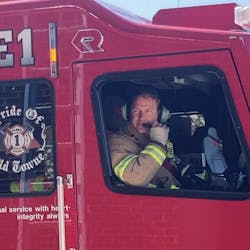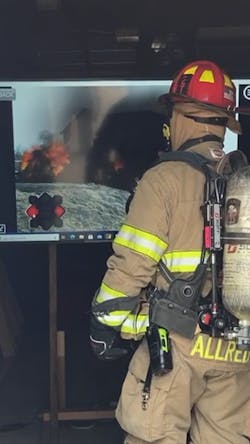Fireground Communications: Back to the Basics and Keeping Things Simple
At almost every incident and particularly at structure fires, fireground communications play a critical role in the overall success of the incident. Unfortunately, communications tend to have a negative effect, to some degree, on the outcome. Any negative effects can be relatively minor, or they can be catastrophic. The extent of the effect depends on the specific variables and circumstances that present themselves at the incident.
So, what do we do about it? At most organizations, communications might be discussed, but they aren’t addressed formally. The main reason is that nobody knows how to formally address communications—or where to even begin.
Take, for example, the communications component that’s included in the NIOSH 5—“inadequate communications.” How do we as a fire service address this? That’s a difficult question to answer, given the very general term of “inadequate.”
Like anything else, we can start by being intentional, and that starts with taking the time to assess and evaluate the organization’s emergency communications.
A formal communications model
When a fire department gets serious about improving its fireground communications, the most important thing that it can do is to adopt a formal communications model. A communications model is a statement that defines how a department communicates via radio. The communications model should be supported by a department standard operating procedure and should be reinforced often, particularly during training and in after-action reviews.
My department (Plano, TX, Fire-Rescue) adopted the 3 Cs communications model (connect, convey, confirm). For example:
Command: “Engine 1 from Command.”
Engine 1’s officer: “Engine 1.”
Command: “Take your line to the second floor.”
Engine 1’s officer: “Engine 1 received. Take our line to the second floor.”
The most important component is the first one—“Engine 1 from Command”—which is the “connect.” When Engine 1’s officer answers the radio (using, according to the 3 Cs model, the “convey”), the individual answers with “Engine 1” and ensures that the connection is made. If Engine 1’s officer only answers, “Go ahead,” command only would know that a connection was made with somebody instead of with Engine 1.
Ideally, the expectation to communicate utilizing the department’s adopted communications model is addressed in the base set of expectations that’s provided by the organization.
In fact, many organizations create a base set of expectations that their small unit leaders (lieutenants, captains and battalion chiefs) simply can add to their specific crew expectations. Regardless, including this expectation is an important piece in the overall process of improving communications.Get all of the players involved
The two groups that most often are overlooked when addressing fireground communications are dispatch and the radio shop.
Fire dispatchers should be included any time that training involves communications. This is particularly true for mayday drills. At Plano Fire-Rescue, the department took this a step further by having annual training that’s tailored particularly for dispatchers. This started five years ago as more of a “Fire Operations 101” but since transformed into a stand-alone fireground communications class for dispatch.
We ask several things of our dispatchers, and rather than just having them “go through the motions,” we want them to understand why. For example, when our crews are en route to a structure fire, dispatchers provide wind speed and direction. In the class, we discuss flow path and wind-driven fires. This information provides dispatchers with the why aspect, so they truly understand the importance of providing this information.
Another example of including dispatch in our communications is with our 3 Cs communications model. Simply put, the more that our crews hear this utilized, the more that it becomes second nature, and the more that they use it. A couple of years ago, we brought our fire dispatchers on board, and they started to use our 3 Cs communications model, too. Now, any time that our crews call dispatch, it sounds like this:
Engine 1: “Dispatch from Engine 1.”
Dispatch: “Dispatch.”
As noted above, answering with the unit designation makes the connection one that involves someone particular.
Radio shop
The radio shop plays a very important role in the success of our communications plan. Our relationship with those folks is critical. The more that they understand what we need, the more that they can utilize their technical expertise to help us to achieve our communications goals.
For example, most of the members of our department wear their radio in a leather case/strap under their fire coat. A few years ago, some firefighters experienced an issue with the volume knob on our Motorola APX 6000 radios rubbing on the inside of the coat, which resulted in the volume being turned down. This had to be rectified as soon as possible.
We turned to our radio shop, and this is what the members of the shop came up with: First, they ordered torque adders from Motorola. These devices are placed under the power/volume knob to stiffen it and, thus, require more torque to turn it. This was a good start that got us headed in the right direction.
Next, the members of the radio shop had the brilliant idea of increasing the minimum volume on our fireground channels. When programming Motorola radios, volume levels can be set anywhere from 0–255 db. At the time, our minimum volume across all channels was 65 db. Our radio shop increased the minimum volume (fireground channels only) to 135 db. When the portable radio volume is turned to its maximum, the level still is 255 db, but when the radio volume knob is turned to its minimum, the volume of the fireground channels is significantly louder than the other channels’ volume is.
The radio shop has helped in numerous other ways, but this is an example that happened early in our journey and really highlighted the importance of establishing and maintaining good relationships with our radio shop.
Note: This issue happened with our APX 6000 radios that weren’t the XE model. We haven’t had this issue since we transitioned to the APX 8000Xs.
Review incident communications
After every fire (or any major/critical incident), you should take the time to evaluate your communications. How was the size-up and 360 report? Did all crews utilize the department’s communications model? Were any transmissions unreadable? How did the department’s partners in dispatch do? Did the department identify any other deficiencies?
Based on answers to these questions, you can get an idea of any trends or specific areas that you must focus on.
This is an important step that shouldn’t be overlooked. Furthermore, don’t forget to include what went right.
Intentional efforts
Although these steps aren’t fully inclusive of all of the aspects that are associated with improving communications, they are a good starting point, particularly when addressing “inadequate communications” as part of the NIOSH 5.
Organizations also should train their crews in radio handling and the mechanics of speaking into the radio (i.e., microphone placement with or without SCBA).
Communications training should start in the academy and be continuous throughout a firefighter’s career. Like any other endeavor, this only can happen when organizations make intentional efforts to improve communications and when company officers and chief officers intentionally support these efforts.
About the Author
Jaime Reyes
Jaime Reyes, who is a 24-year student of the fire service, serves as a battalion chief with Plano, TX, Fire-Rescue. He is assigned to Battalion 1, B-shift. Reyes serves on the executive board for the Plano Firefighters Association IAFF Local 2149. He holds a bachelor’s of science degree from Texas A&M University.

